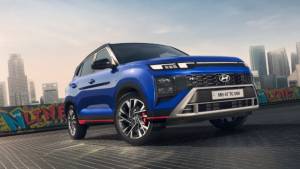Siren song
To date the passenger 4x4 segment in India was a close knit community where almost every vehicle within that community was an SUV. There were less than handful of exceptions of course, such as the cars from Audi which sported quattro technology, and apart from those there has never been any variation to the 4x4 theme.
So for Tata Motors to introduce a MUV with 4x4 was a very bold move indeed, especially in India where very few understand what 4x4 is and whether it's a benefit or bane. Globally 4x4 straddles everything from hatchbacks to sedans, estates, utility vehicles and of course the more celebrated SUVs. And while in most cases 4x4s are purely for show for many they ideally fits personal needs
Now 4x4 is quite simply a system that provides power or rather torque to all four wheels. This enables you to have better dynamic abilities and of course also helps you drive across surfaces that would prohibit 2WD sedans or hatches from travelling any further. But in an MUV? Does it make any sense at all? And that is why we decided to pit the Tata Aria against what passes off as its closest competitor, the Skoda Yeti to understand if there is any difference at all.
DESIGN
The Aria is built to look like an MUV. From the front to the rear it has a continuity that makes it look like a one-box, almost but not entirely a van. It is the shape of that front end; behind the grille the hood slopes sharply upwards towards the windscreen that makes it look distinctively like an MUV. If you go by what conventional SUVs such as the Yeti look like, you'd notice that the hood on the Yeti is nearly flat with an almost vertical face. Not the friendliest form where pedestrian safety is concerned unlike the Aria, yet without convincing enough crash test data about either vehicle I wouldn't pass judgment on which is safer.
Move on towards the passenger cabin and the Aria looks longer and taller and it is. The Yeti though shorter looks nearly as tall thanks to much larger and vertical glass areas.
At this point I should move to explaining the purpose of either design but allow me a second to take styling into consideration. The Aria is quite unlike anything Tata Motors has ever drawn up so far. It is attractive and will appeal to those looking for a slightly traditional form. It is a very classily executed job and in certain colours draws attention to the elegant fluidity of its lines and well toned form. But it isn't as funky or as lively and fresh as the Yeti.
But getting back to the purpose of their design, the Yeti is an SUV and that means you can drive it not just across muck and sticky patches but also up and down steep inclines. For uphill or downhill mobility what you require is not just higher ground clearance but also good angles of approach and departure and less distance between the front and rear wheels or wheelbase. In this respect the short overhangs at both ends and a short wheelbase (2578mm) allows the Yeti better maneuverability across any kind of terrain. The Aria is largely handicapped because of its fairly longer (2850mm) wheelbase which reduces maneuverability in tight spots, though with 20mm more ground clearance and nearly as good approach and departure angles as the Yeti it is quite an accomplished off-roader.
The exterior design also impacts the interior look and feel and the interior experience in either is as different as the New Zealand apple from the Himachal kind. The Yeti is strictly a five-seater with little room inside to place a third row of seats allowing it to have enormous boot space. In that respect the Aria with its three rows of seats can definitely seat up to seven passengers. The foldable third row seats though aren't optimised for long distances since leg room is limited. The third row also eats into the boot area when the seats aren't folded up, though pack the seats away and there's far more space available than the Yeti.
Now the Yeti was designed and built in Europe to cater to European sensibilities. So the interior has flavours characteristic to all European cars, such as solid build, superior materials, well thought out ergonomics and impeccable finish anywhere you look. The dashboard has the same premium look and feel as the Superb though I personally found the actual wood veneer a bit plasticky. In contrast the wine and black leather and wood in the Aria does look a bit tacky though the quality is as good as it gets for the price. Fit and finish for a Tata product is impressive and the lack of panel gaps and the styling shows that Tata Motors has paid a lot of attention to the details. Yet there are some glaring errors. It's as if there were too many details to look into and some elements that could have been better executed have passed muster in a typical 'chalta hai' fashion.
DRIVETRAIN
The interesting bit is that both vehicles have different displacement engines but make the same amounts of power and torque. The Aria has the larger 2.2-litre DICOR while the Yeti has a smaller 2.0-litre common-rail direct injection mill. Both are turbocharged and make exactly 140PS and 320Nm of max torque. Yet the way these ratings are manifested gives both entirely different driving characteristics. You see the Aria's max power is generated at a higher 4200rpm whereas in the Yeti it peaks at 4000rpm. Now 200rpm may not be much but it allows the Aria slightly higher top whack as it is able to hold its max power for a bit longer. Also the Aria's max torque which in case of an MUV or SUV is far more essential than the power it makes, comes in at a slightly earlier 1700rpm and stays longer up till 2700rpm. This enables the Aria to have better driveability as well as initial pick-up. Quite simply on paper it means that the Aria's engine performance even with seven people on board will be better than that of the Yeti simply because it starts working at it earlier.
Theoretically this also means the Aria should have better driveability and thanks to the turbo kicking in early at around 1700rpm it is fairly an easy mover in urban areas. The Aria's engine does not have to be worked too hard; it is by far one of the best engines Tata Motors have in the fold right now. But the Yeti has slightly better gearing and is also much lighter and that allows it as much flexibility as the Aria.
But what makes these vehicles unique is not their engines but their 4x4 drivetrain. The Aria is the first MUV in India to have 4x4 and that alone elevates it above all other MUVs. Compared to the Yeti it does offer a slight variation on the same theme. Where the Yeti is a full time 4WD SUV, the Aria can shift between 2WD and 4WD on the fly. This allows the Aria's engine to operate more economically when driving in urban areas as opposed to the Yeti. The Aria and the Yeti can also shift torque as required between the four wheels in challenging off-road conditions though without a low ratio those capabilities are restricted beyond a limit.
The Yeti in addition provides a hill descent feature which allows you to drive on a gravel strewn downhill track without the vehicle losing traction and sliding down in freefall. As opposed to that what the Aria provides is ESP which ensures immense stability when driving off-road, the ESP behaves in the same manner it does on road by regulating power and braking force between wheels that have traction and those that do not.
So the question of which is better off-road is one that has no answer simply because both will take you just as far one way or the other.
DYNAMICS
So does a people mover behave vastly different compared to a sports ute on the road? Of course it does and that's because both have entirely different types of construction. The Yeti has a monocoque chassis and since the body forms a rigid part of the chassis it is stiffer, has less flex and is much more capable of holding a firm stance round corners than a body-on-frame vehicle such as the Aria.
Now the body-on-frame construction is what a proper off-roader needs and the Aria's chassis clearly indicates that the platform will support an SUV in the near future, which will be the new Safari. And because the Aria has a body-on-frame construction it is less rigid and therefore exhibits body roll. Yet on the road the Aria is composed and though there is some amount of body roll, it's been kept well under control thanks to well set up suspension. It has a standard independent MacPherson unit at the front and a multi-link rear but both spring and shock absorber ratings are stiffer than expected and this gives it a fair amount of stability. It isn't as impressive as the Yeti which also has a fairly stiff yet compliant suspension set-up but is also complemented by a well balanced track-to-wheelbase ratio so the rear always knows what the front end is doing. And then there's the ground clearance. Because the Yeti is closer to the ground the centre of gravity is also lower than the Aria complementing the dynamic abilities. The Yeti also needs less steering effort than the Aria because its hydraulic steering has a electro mechanical assist that reduces effort in urban driving cycles but gives enough feedback when speeds rise and corners come faster.
On the aspect of ride too, the Yeti seems the more capable though it's a matter of what kind of ride individuals prefer. The Yeti as I mentioned is stiff but very compliant; it is well suited to Indian conditions with excellent shock absorption abilities. Yet there is a slight stiffness to this ride which over a couple of hours of driving gets exhausting.
The Aria though is softer and will appeal to those looking for more cushioning. It too has a fair amount of stiffness but enough to not feel any bumps and potholes without compromising body roll.
PERFORMANCE
So with equal power and torque ratings it's the details such as kerb weight, gearing, tyres and aerodynamics that make a difference when it comes down to pure on-road performance. With lower kerb weight, better gearing, smaller profile and less sticky tyres but the aero of a brick with rounded edges the Yeti is still quicker to a 100kmph by 4 seconds. The Yeti takes 10.43 seconds to do a 100kmph, compared to 15.65 seconds by the Aria. This clearly indicates that body weight, in the case of the Aria a massive 2.25 tonnes, does undermine performance, though take a close look at the roll-on times and you'd also notice the linearity of the Aria's engine. It posts consistently quick times for all gear speeds, unlike the Yeti and that clearly indicates driveability in the Aria will be superior.
Where fuel efficiency is concerned, the Aria is better off than the Yeti, simply because you can choose to switch off 4WD and stick the Aria in 2WD; less stress on the engine is rewarded with cheaper operating costs. In the city or on the highway the Aria can stretch a litre longer than the Yeti and this is also partly because its turbo kicks in earlier than the Yeti giving the Aria more linearity and better, stress-free driveability.
LIVING WITH IT
What the Aria does not do is provide the aura of luxury as well as the Yeti does. At the end of the day whatever Tata Motors or Skoda claim, they aren't targeting an enthusiast buyer who in the case of the former may want to take his entire family into the hinterland of Ladakh or the latter who is just looking for good off-road fun. What either is targeting is the luxury buyer. But Tata Motors' interpretation of luxury is just a bit different from Skoda. Yes, fit, finish and styling are important, I can see design cues emerging from Range Rover in the Aria, but it's also important to understand just what type of materials, craftsmanship and details are
termed luxurious. Ironically there's another argument here. The smaller less efficient utility vehicle, the Yeti, costs more than the larger, more efficient Aria which by default to the Indian psyche spells better value. Yet in any metro or large town, the Aria is far more cumbersome and heavier to drive than the Yeti, not to mention tougher to park if at all you find a slot large enough, a problem the Yeti may seldom face since it's just around 200mm longer than a large hatchback or mid size sedan. So where the Aria has more affordable costs of living with it the Yeti is certainly the one simpler to live with.
The Aria is also rich in features and most of them practical, useful and innovative though I am not referring to the overhead collapsible bins which I think are just ridiculous. In the current market scenario no manufacturer is able to provide at the same price or anywhere close to that of the Aria features like rain-sensing wipers, auto headlamps, cruise control, GPS navigation though not highly accurate or user-friendly, can still be handy to give you an average sense of where you're heading and a glove box chiller. In stark contrast the Yeti almost feels basic even in the top-of-the-line guise.
VERDICT
It's not going to win any awards. It certainly didn't ours but there's no denying that the Aria is quite simply a stupendous and highly admirable effort. It ticks all the right boxes, which was a bit surprising. But then no matter how Tata Motors wants to position the Aria, it is still a people mover. How else do you explain the seven-seat configuration. Just for the ability to take your whole family, dog, cat and parakeet far beyond where the blacktop ends earns it top billing. So if what you are looking for is a practical, efficient, comfortable and stylish people mover, take a close look at the Aria. It is nearly a lakh cheaper even and has way more equipment than anything in this segment can offer in addition to the bare essentials that are space, comfort, efficiency and drivability.
But the Yeti scores two stars more, firstly because what the Yeti has loads of and the Aria little of is the fun factor. And here at OVERDRIVE, fun rates a bit higher than sensibility and practicality. Any other SUV even without a 4x4 drivetrain would still be hotly demanded, so the Aria's target audience is also the same bunch thats looking to have some fun. Otherwise the Aria could have worked just as well with only 2WD - why add the cost of a 4x4 drivetrain?
The second star for the Yeti is simply because at the back of your head and even mine, there is a niggling thought - is the Aria dependable? I know it can get me to the back of beyond but will it reach its destination without a hiccup? And least of all is the fact that Tata Motors vehicles seem to age a whole lot quicker, so in just six months your Aria could (I'm not saying it will since we haven't had a long-termer yet to evaluate the aspect fully but this is my experience gauged from previous models) look a year old. Reliability and build has to date been the bane of Tata Motors. And that is principally where the Yeti makes a better case for itself. It is as good as the Aria and will remain so way longer.















